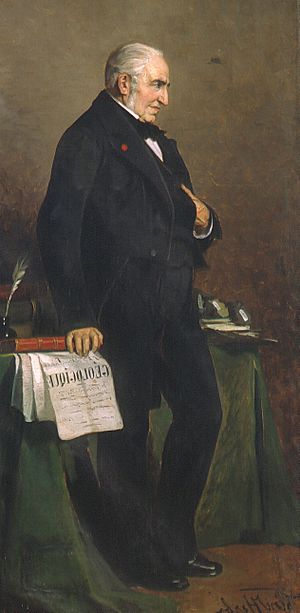Jean Baptiste Julien d'Omalius d'Halloy facts for kids
Jean Baptiste Julien d'Omalius d'Halloy (born February 17, 1783, in Liège; died January 15, 1875, in Brussels) was an important Belgian geologist. He studied the Earth's rocks and how they formed. He also wrote about different groups of people.
Contents
Early Life and Learning
Jean d'Omalius d'Halloy grew up in Liège, Belgium. He was the only son in a well-known family. His parents made sure he had a good education.
In 1801, he went to Paris to continue his studies. There, he became very interested in geology. He loved reading books by famous scientists like Buffon. He also visited museums and gardens that displayed natural history.
He went back to Paris in 1803 and 1805. During these trips, he attended lectures by top scientists. These included Fourcroy, Lacépède, and Georges Cuvier.
On his way home, he often explored the geology of northern France. By 1808, he had already written a paper about the geology of that area. This made him want to create a geological map of the entire country. He even got a special permission to do this work, which meant he didn't have to join the army.
Mapping the Earth's Layers
Jean d'Omalius d'Halloy worked very hard on his geological map. By 1813, he had traveled over 25,000 kilometers (15,500 miles). He explored France and parts of Italy.
His family, however, didn't fully support his geology trips. They convinced him to stop his long expeditions. The map he created of France and nearby areas was finally published in 1822. This map was very important. It became the base for more detailed maps made later by other geologists.
He was one of the first people to really understand modern geology. He helped create the basic knowledge of geology in many places. He studied the Carboniferous rocks in Belgium and the Rhine area. He also looked at the younger Tertiary rock layers in the Paris basin.
A Scientist and Leader
Besides his science, d'Omalius d'Halloy also worked in government. In 1814, he became a local official in Dinant. In 1815, he became the general secretary for the province of Liège. Later that year, he became the governor of Namur. He held this important job until the Belgian Revolution in 1830.
Even though his government duties took up a lot of time, he never lost his love for geology. He still did some field work when he could. In his later years, he also studied ethnology, which is the study of human cultures and races.
In 1848, he was elected to the Belgian Senate. He became its vice-president in 1851. He was also a member of the Belgian Academy of Brussels starting in 1816. He even became its president in 1850.
Ideas on How Species Change
Jean d'Omalius d'Halloy had interesting ideas about how living things change over time. In 1846, he wrote that it was more likely that new species came from older ones that had changed. He thought this was more probable than each species being created separately. He had first shared this idea back in 1831.
This idea was similar to what Charles Darwin later wrote about. In 1861, Darwin published the third edition of his famous book, On the Origin of Species. In it, Darwin added a section that gave credit to other scientists who had similar thoughts. He mentioned d'Omalius d'Halloy as one of these important thinkers.
Later Life and Achievements
D'Omalius d'Halloy was an active member of the Belgian Academy of Sciences from 1816. He was president of the Academy three times. He also led the Geological Society of France in 1852.
He continued to study the Earth's layers, especially in the Paris Basin. He was able to clearly show the extent of certain rock layers on a map in 1817. He was also known for his work in ethnology. When he was almost 90 years old, he was chosen to be president of a big meeting about pre-historic archaeology in Brussels in 1872.
He was a religious person throughout his life. He believed that faith and science could work together in harmony. He even gave a speech about this idea in 1866.
He passed away in Brussels on January 15, 1875. He was 91 years old. His death was partly due to a scientific trip he took by himself when he was 90.
Some of his published works include:
- Description géologique des Pays-Bas (1828)
- Eléments de Géologie (1831)
- Introduction à la Géologie (1833)
- Coup d'oeil sur la géologie de la Belgique (1842)
- Precis elementaire de Géologie (1843)
- Abrégé de Géologie (1853)
- Des Races humaines ou Eléments d' Ethnographie (1845)


